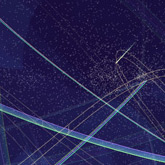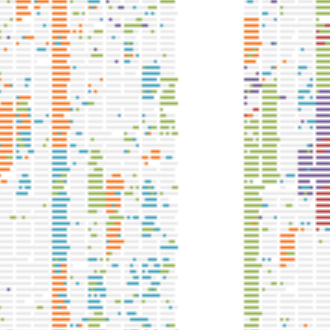
Personal Projects (2010–2012)
Searching for numbers in the digits of π (mobile app, online site, interactive installation)
The rise and fall of companies and their subjective editorial rankings.
A reconstruction of Mary Shelley's Frankenstein using parts of incomplete fonts found in PDFs from the internet.
Personal & Commissioned (2004–2009)
An interactive installation for watching the evolution of Darwin's On the Origin of Species.
The initial sketch that led to the traces project; an interactive comparison of six books and a million words.
A map of cities and mountains, compiled from 26 million segments of road.
Sketches for an illustration based on the publicly available Enron email data set.
Sequences of human DNA aligned with about a dozen other mammals, created as an illustration for Seed Magazine.
Masthead image created for William Safire's On Language column in the New York Times Magazine.
An update to disarticulate, created for the 2006 Cooper-Hewitt Design Triennial to be shown alongside Processing.
Illustration for New York Magazine's “High Priority” feature in April, 2006.
Cover for the journal Nature, announcing the completion of the first phase of the HapMap project.
An illustration of how the gene FOXP2, believed to be connected to language, differs in humans versus chimps.
A look at how code and graphics comingle in Atari 2600 game cartridges.
What baseball teams are spending their money well, and how does it change over the course of the season?
Uses a similar method to dismap to interpret Casey Reas' articulate piece. Created as a large format print commission.
Ph.D. Projects (2000–2004)
Poster of the entire code from a Nintendo cartridge, linked together to show how it operates
Nintendo game cartridges reveal a beautiful soup of the thousands of elements that make up the game screen.
The evolution of code history over dozens of revisions, seen simultaneously.
Depiction of the civilian casualty count in the Iraq War
A deconstructed Nintendo emulator that shows how sprites and sprite memory are handled while a game is being played
Large format (9 x 18 feet) print of all the known and predicted genes in the human genome
Installation depicting thirteen million letters (one quarter) of human chromosome 21, colored by their use
People willing to trade their freedom for temporary security deserve neither and will lose both
A later adaptation of the Valence project that visualizes biological data, and was created for the 2002 Whitney Biennial.
A three dimensional genome browser seen in Ang Lee's Hulk.
Large-scale (72 x 24 inches) print using machine shop security camera data to reveal usage patterns
Explanation of the rendering engine that eventually became the graphics portion of the Processing API.
Poster depicting all the genes of chromosome 14 in the human genome
Video documentation of the atmosphere project
The A, C, G, and T letters of human chromosome 22 shown in a three pixel font
A redesign of traditional diagrams of the genetic code to clarify and highlight patterns in the data. Includes an interactive version that depicts how the code works.
The biologist's calculator: a genome browser that runs on a handheld device.
Combination of several different representations of haplotype data into a single interactive tool.
Implementation of the CAST algorithm to cluster microarray data, developed for a class project
Sketch working out typography in n-dimensional space, created while developing the Atmosphere project for a MoMA exhibition
A series of visual studies; large format print pieces looking at repetition, form, and structure of data.
Masters Projects (1998–2000)
A web browser that constructs typographic sculptures from the text content of web pages
Series of posters designed for the 1999-2000 Colloquium Series at the MIT Media Lab
Simulation of mixing two immiscible fluids, such as oil and water.
Valence is a set of software sketches about building representations that explore the structures and relationships inside very large sets of information.
Using organic information design to visualize the changing structure of a web site, juxtaposed with usage information.
I was curious about how the numbering works for postal codes in the states.
An antagonistic painting tool.
Assignment for Numeric Photography course.
Assignment for Numeric Photography course depicting the Fall colors at the Media Lab.
Assignment for Numeric Photography course.
Assignment for Numeric Photography course.
Several video experiments with video input from Fall of 1998.
Undergrad Projects (1993–1997)
A collection of history, ideas, and rambling about typography from Junior year of undergrad design school.
Instructions on how to make a paper airplane, from freshman year studio during undergrad.

















